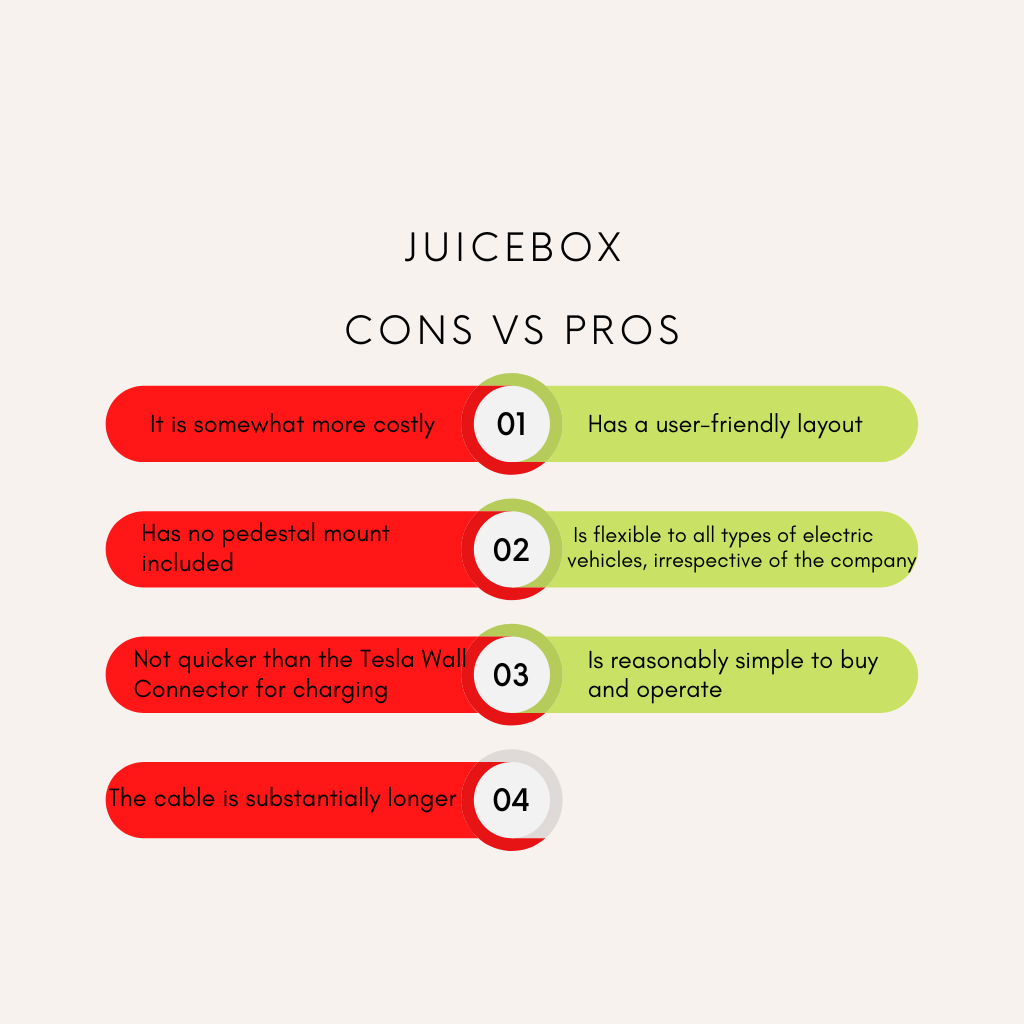Today will dive deep in : Tesla Wall Connector Vs Juicebox, what to choose? Pros and Cons ?
Although these vehicles save the planet and customers spend less on gas, a new dilemma for electrical vehicle owners arises: what type of charging should I get for my car?
The Juicebox’s modest price premium over the Wall is the primary difference between the two products.
It is adaptable, though, as it may be utilized with various electric vehicles made by multiple automakers. On the other hand, Tesla’s function better with its own goods.
Tesla Wall Connector Vs Juicebox

Tesla Wall Connector vs Mobile Connector [Complete Comparison]
There are a few features of these two ports that are directly comparable:
Level 2 chargers include the Tesla Power Adapter and the Juicebox. These take a little installation effort, but they both power faster than a level one charger.
Both are connected to a generally dependable Wifi connection. These chargers allow you to keep your gadgets online while being charged.
Additionally, you may use an application with both adapters to check your car’s current charge while it sets. The application can also be used to start and stop charging.
When it concerns installation costs, they are comparatively similar. But chances are you’ll need to employ an expert unless you’re an electrician.
This will guarantee that the port complies with both local laws and the requirements of the auto chargers. Although setup costs range from $250 at the low end to $1,900 at the upper back, they are roughly $750 in general.
Differences : Tesla Wall Connector Vs Juicebox
Tesla Wall Connector vs Juicebox are similar, but differ significantly in some crucial ways.
The biggest of these variations are as follows:
- • Adapter cables
- • What every charger is capable of
- • Cost
- • The variations in billing rates

It undoubtedly has certain advantages and disadvantages, as mentioned above. The fact that it is more adaptable for usage with electric cars is arguably the most significant advantage.
The Juicebox is meant for use with any electric vehicle, whereas the other one is made specifically for a Tesla.
Almost any owner of an electric car can operate it efficiently because of its straightforward design and intuitive, user-friendly interface.
But, the fact that the adapter itself costs more and recharges more slowly is a significant drawback.
Regardless of the vehicle, it recharges at around 30 miles (48.3 km) per hr, 14 miles (22.5 km) per hour lower than the Tesla adapter. Additionally, the buying price is around $100 higher.

The primary drawback is that it was created exclusively for Tesla vehicles. This makes it the greatest product available for a driver because driving a Tesla makes this less of a concern.
But it is considerably more challenging to customize the charging to your requirements if you use another electric car.
How to Choose
For people who own a Tesla, the Wall Connector is ideal; for those who don’t, the Juicebox might be a better option.
Both are of the highest caliber and have received excellent reviews.
Selecting the best home charger is crucial to making the most of your EV. If a Tesla is your sole vehicle, the Wall Connector is the clear winner because it is less expensive.
But the Juicebox offers a financial advantage over most adapters in the industry if your household charger will be utilized to charge more than one vehicle or a non-Tesla EV.
The Juicebox’s most vital feature is its ease; it’s simple to purchase, needs one professional call for installation, and operates simply by plugging it in and charging your devices.
It includes all the features you would anticipate, like an app-based connection, a rechargeable scheduler, Internet, and a longer cord that is useful for private and public parking places.
Due to the lack of a pedestal installation, the Juicebox must be put on a wall that can support the weight of the charger and the long, heavy wire.
With Tesla, this is not a problem because you can purchase a Wall that is a pedestal placed in its place.
Despite the lesser power, many customers shouldn’t have any problems with the Juicebox’s recharging abilities.
Range increments of 30 miles per hour might be expected at the highest rated power of 9.6kW. In contrast, you can charge your vehicle at a rate of about 44 miles per hour.
Read also : Is Tesla Home Charger Worth It? [Complete Guide]
In the same series , you want to check also :
- Tesla Wall Connector Vs Third Party
- Tesla Wall Connector Vs ChargePoint
- Tesla Wall Connector Vs Nema 14-50
Conclusion
We still advise owners to purchase the Wall Charger. The Juicebox is a convenient, readily available solution for everybody else that you won’t regret using.
Although it costs slightly more than the Tesla Wall Connector, the second one is suitable for most owners.
Just as automakers must acknowledge the demand for affordable EVs, charger producers must produce cheap chargers.
The market needs a multifaceted strategy to reduce the cost of owning and buying an electric vehicle to drive EV adoption in North America. When viewed from that perspective, the Juicebox is a positive development.